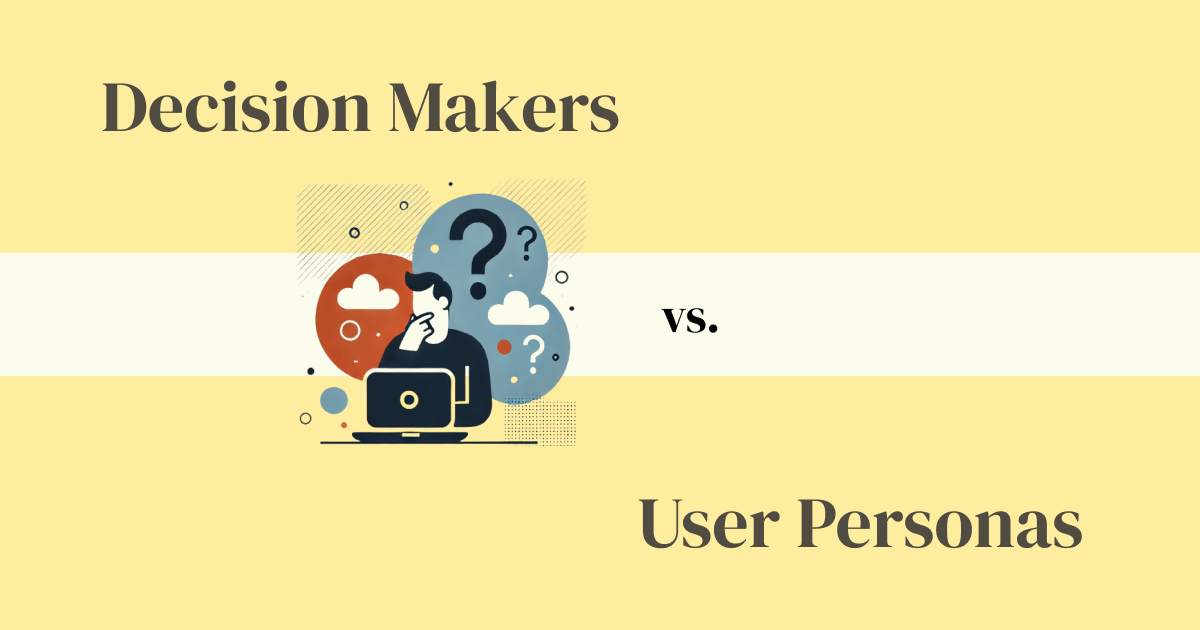Decision Makers vs. User Personas
In business and marketing, decision-makers and user personas are like chess pieces. One, the decision maker, holds the power, making key moves that decide the fate of products and strategies. The other, the user persona, embodies the target audience, guiding the direction of marketing efforts and product development.

Understanding the differences, interplay, and synergies between decision-makers and user personas is more than just a marketing tactic; it's a strategic imperative. By balancing the insights from both, businesses can create more effective products, services, and marketing strategies, ultimately driving success and growth.
Understanding User Personas
A user persona is similar to a detailed character sketch in a novel or screenplay. Just as a character sketch provides a vivid, descriptive portrayal of a character's traits, background, motivations, and behaviors to help writers understand and develop their characters more fully, a user persona serves a similar purpose in product design and marketing.
A user persona is a fictional yet realistic representation of your target audience. It is a detailed, collective profile of your customer base and includes demographic information, behavioral patterns, motivations, goals, and pain points. This rich, detailed profile helps designers, marketers, product developers, product managers, and other stakeholders understand and empathize with the users they are designing or building for.
It guides decision-making in product development, ensuring that the product aligns with its intended users' needs, expectations, and preferences. In more technical terms, a persona encapsulates a specific customer group's common behaviors and characteristics.
Key Elements of User Personas
User personas generally include certain key elements such as:
- Demographic and sociographic information: This encompasses basic details like age, gender, occupation, and socio-economic status and helps in understanding who the users are.
- Behaviors: This details how the user interacts with a product or service. What are their habits, preferences, and common activities related to the product?
- Challenges and pain points: Identifying the problems users encounter is crucial. This helps in developing solutions that address these specific issues.
- Environment: The context in which the user interacts with the product, such as the physical, social, or cultural environment, can affect their experience.
- Technology usage: Understanding the user's comfort level and familiarity with the technology can guide the design and functionality of a product.
- Motivation, objectives, and goals: What drives the user? What are they trying to achieve by using the product or service? Understanding their goals helps align the product's features and functionalities with the user's needs.
- Usage context: This aspect covers the specific circumstances under which your customers interact with your service, including the engagement timing, their particular actions, and how frequently they perform these actions.
Importance of User Personas
The importance of user personas can be understood from various perspectives:
- Empathy: They help teams empathize with the users, seeing the product from the user's perspective.
- Focus: Personas keep the user at the forefront of the design process, ensuring that decisions are made with the user's needs in mind.
- Communication: They provide a common language for teams and stakeholders, ensuring everyone has the same understanding of who the users are.
- Decision making: Personas guide feature development, design choices, and prioritization by aligning them with user needs.
- Consistency: They help maintain user-centric consistency across different features and aspects of the product.
Understanding Decision Makers

Decision makers are the key individuals who have the power and authority to green-light a project, approve a budget, or select a product or service for their company.
They come in various forms - CEOs, product managers, department heads, and even board members. Each one, depending on their role, views decisions through different lenses: financial impact, strategic alignment, operational efficiency, and employee wellbeing.
Decision-makers typically possess a deep understanding of their business's overarching goals and are often under pressure to make decisions that align with these objectives. Their decisions are driven by data, experience, and foresight. They're not just thinking about the immediate impact but also about how their choices will resonate in the long run.
Key Characteristics of Decision Makers
To better understand these pivotal figures, let's break down their characteristics:
- The role of authority and responsibility: Decision makers often hold positions of significant authority within their organizations. Their decisions can have a profound impact on the organization's direction, profitability, and market position.
- Risk assessment and management: These individuals are often tasked with assessing risks. They weigh the potential benefits of a decision against the possible pitfalls. Decision-makers must discern which opportunities will bear fruit for their organization.
- Financial acumen: Decision makers typically have a keen understanding of financial matters. They need to balance the books, ensuring that their investments today won't sink the company's finances tomorrow. They are like careful householders, guaranteeing the family budget is spent wisely, bringing the most value and benefit.
- Vision and foresight: A critical aspect of a decision-maker's role is the ability to look beyond the immediate horizon. They need to foresee market trends, technological advancements, and shifts in consumer behavior.
- Communication and influence: Decision makers must also be skilled communicators. They need to articulate their vision and decisions clearly to stakeholders, from employees to board members and sometimes even the public. Their ability to persuade and inspire can be crucial in gaining buy-in for their decisions.
- Balancing stakeholder interests: In their decision-making process, they must balance the needs and interests of various stakeholders – employees, shareholders, customers, and suppliers.
- Adaptability and learning: The best decision-makers can adapt to changing circumstances. They are continuous learners, always seeking to update their knowledge and skills. They understand that the business world is not static and that flexibility and adaptability are key to survival and success.
Difference Between Decision Makers and User Personas
While user personas and decision-makers are crucial, they have different needs and perspectives. The user persona cares about experience, usability, and satisfaction, while the decision-maker is concerned with value, ROI, and efficiency. They're like two sides of a coin.
So, how do you cater to both? Consider a company like Apple. They expertly balance the needs of decision-makers (value, technology, status, profits) and user personas (design, user experience, brand loyalty).
Incorporating Feature Flags: Catering to User Personas and Decision Makers
Feature flags are a powerful tool in modern software development used to toggle features on or off dynamically. They play a pivotal role in bridging the gap between user personas and decision-makers, offering unique benefits to both:
For User Personas
- Personalized user experience: Feature flags allow a customized experience for different user personas. Imagine a trading app that can switch between a simplified interface for casual traders (User Persona A) and a more detailed, feature-rich interface for power users (User Persona B). This flexibility ensures that each user persona has an experience tailored to their preferences and needs.
- Testing and feedback: Feature flags enable the rollout of new features to a subset of users for testing. Companies can gather valuable feedback by engaging user personas in the testing phase, ensuring the final product resonates well with the target audience.
- Reduced risk of negative impact: By using feature flags, companies can minimize the risk of introducing a new feature that might not be well-received by all user personas. If something goes wrong, the feature can be turned off instantly without affecting the overall user experience.
For Decision Makers
- Controlled rollouts and risk management: Feature flags offer decision-makers control over the release process. They can mitigate risks by gradually rolling out a feature to users. This controlled rollout process reduces the risk of widespread issues and allows for smoother implementation.
- Data-driven decisions: Decision makers thrive on data and insights. Feature flags provide them with real-time data on how new features are performing.
- Resource and budget management: Decision makers can optimize resource allocation and budget with feature flags. Features that don't perform well or resonate with users can be quickly turned off, saving the company from investing further in unfruitful directions.
- Long-term strategic planning: Using feature flags, decision-makers can align software development with long-term business strategies. They can plan for phased feature releases in line with market trends, competitor actions, and overall business goals.
Bridging the Gap
In the interplay between user personas and decision-makers, feature flags serve as a versatile tool. They allow for a dynamic and responsive approach to software development and product management. The key is in how these flags are utilized:
- For user personas, it's about delivering a personalized and satisfying user experience, testing, and refining features based on their feedback.
- For decision makers, it's about managing risks, making informed decisions based on real-time data, and ensuring alignment with broader business objectives.
Conclusion
Mastering the balance between decision-makers and user personas is key to business success. Feature flags are like the adjustable sails of a ship, helping navigate the winds of user needs and business goals, ensuring a journey that's beneficial for both user personas and decision-makers. By leveraging this tool effectively, companies can create products that not only delight their users but also contribute to the strategic success of the business.
ConfigCat is a developer-centric feature flag service with unlimited team size, awesome support, and a reasonable price tag. They support simple feature toggles, user segmentation, and A/B testing and has a generous free tier for low-volume use cases or those just starting.
For more feature flagging goodies, stay connected to ConfigCat on X, Facebook, LinkedIn, and GitHub.
